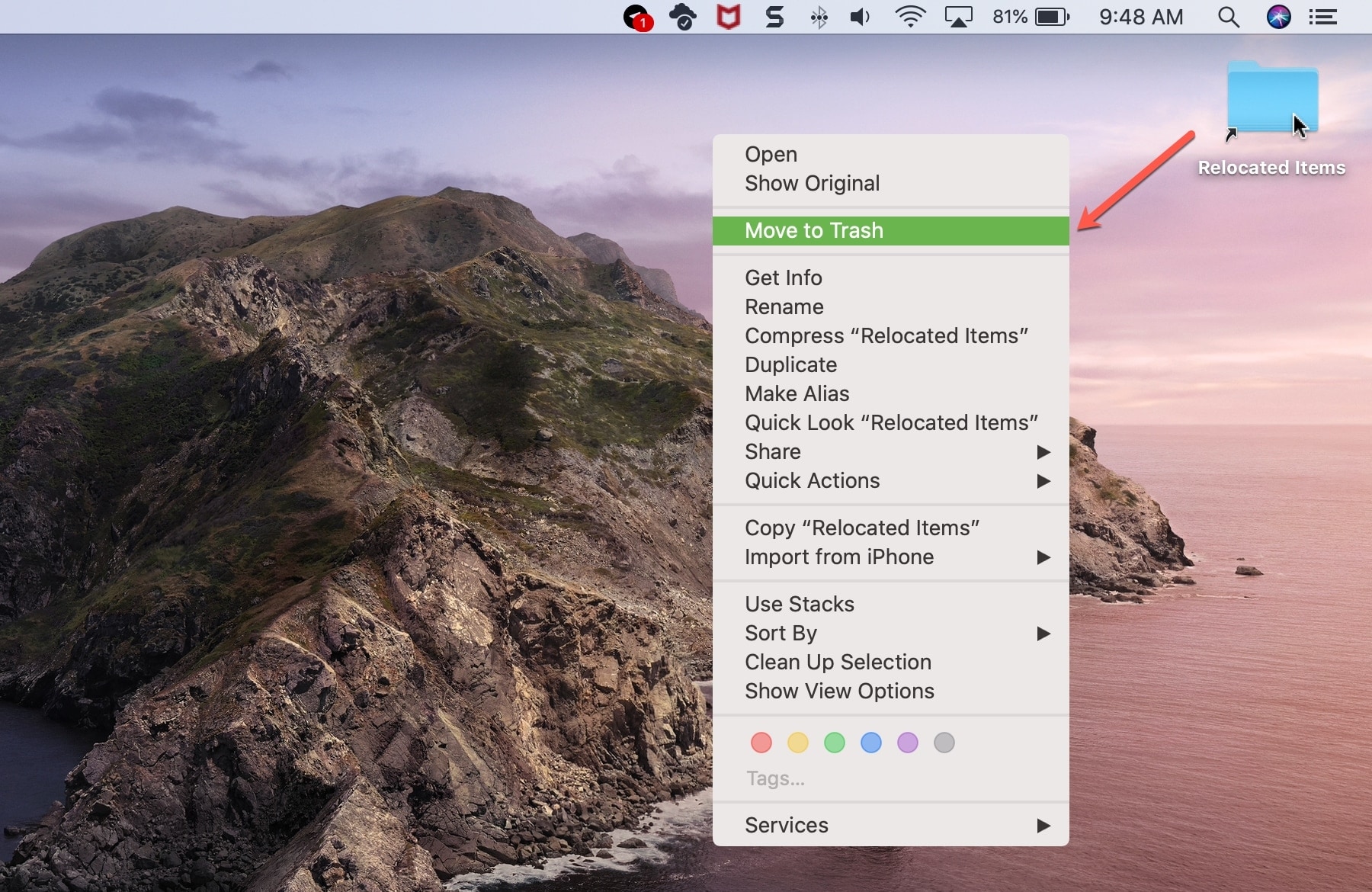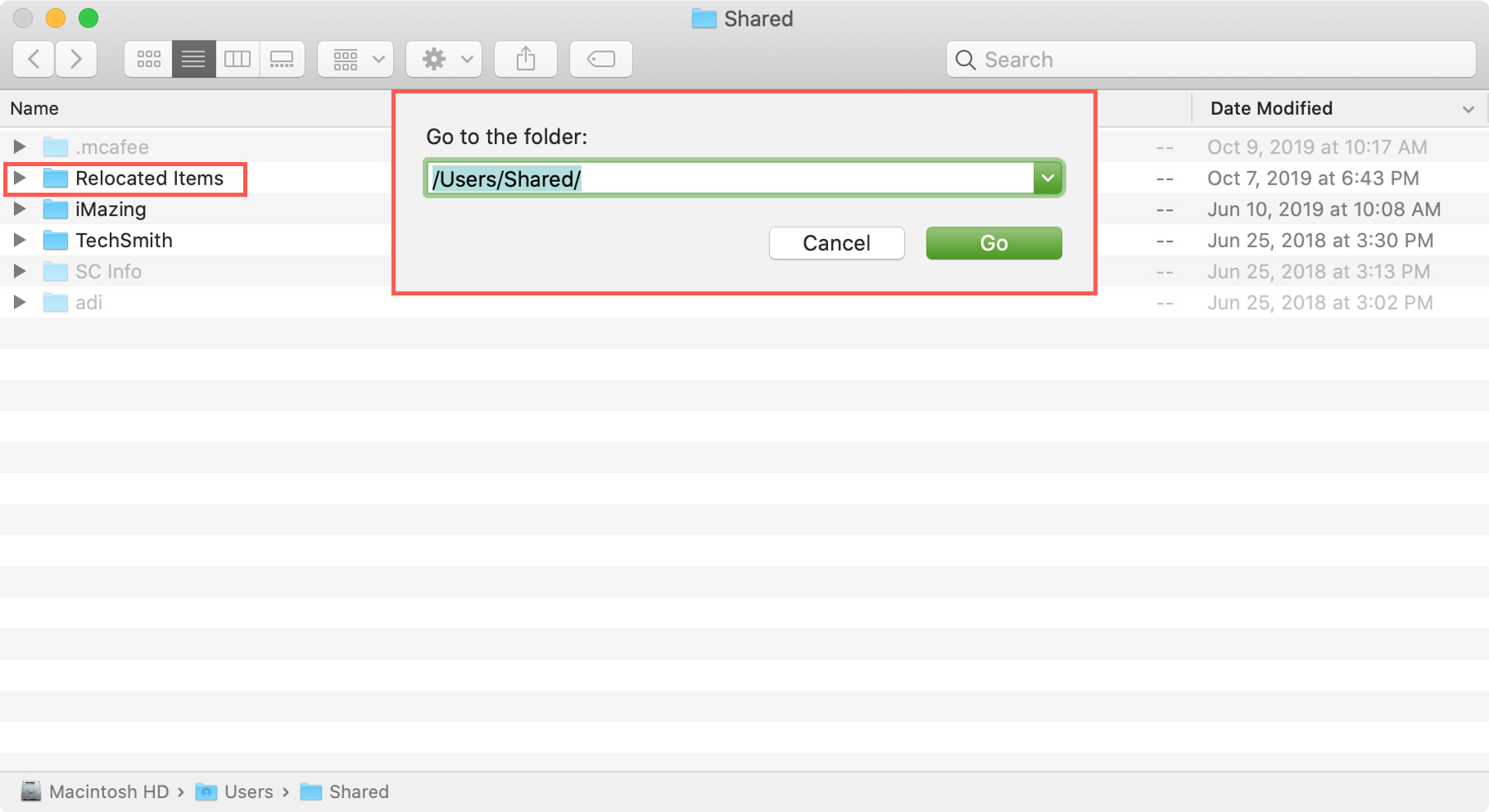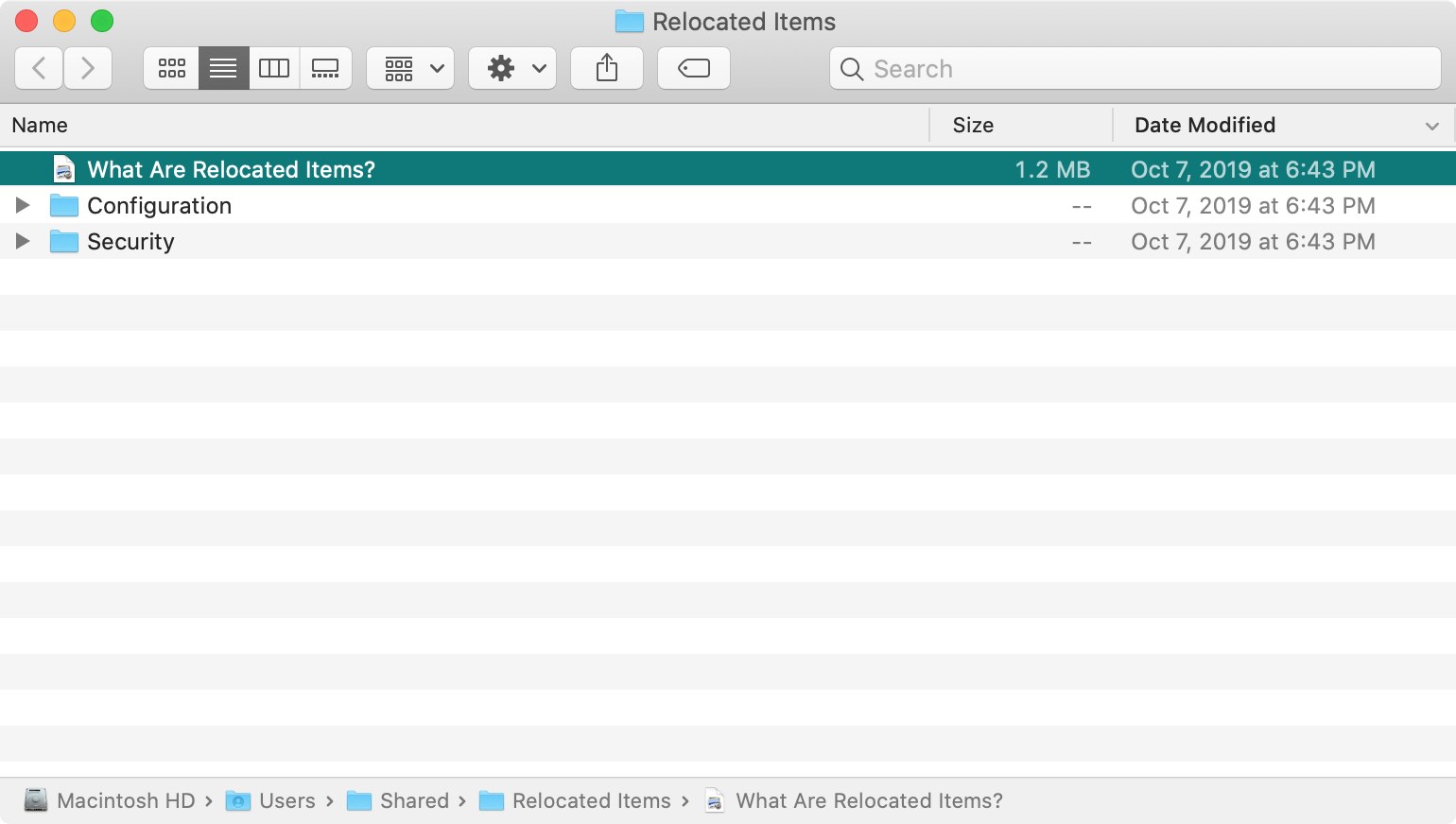Understanding Your **Catalina Relocated Items**: What They Are And What To Do
When you hear the name "Catalina," your thoughts might, in a way, drift to a rocky island, a truly charming spot off the coast of Southern California. It’s a place, you know, for making memories that will last a lifetime, with brilliant blue water and fascinating sea life that really beckon. This magical island, actually, has been attracting visitors for more than 100 years, offering a perfect place for relaxation and play, whether you're coming for the day, weekend, or longer. Yet, for many Mac users, "Catalina" brings up something quite different, a kind of digital discovery right on their computer's desktop: the "Relocated Items" folder.
This folder, basically, shows up after you upgrade your Mac to macOS Catalina or a newer version, and it can be a bit of a surprise, can't it? It’s not, you know, like finding a hidden cove on an island adventure; it’s more about finding files your computer moved around during the big system change. So, many people wonder, "What exactly are these catalina relocated items, and what am I supposed to do with them?"
We’re going to help you get a good grip on what this folder is all about, why it appeared, and what steps you can take to manage its contents. It’s, you see, a pretty important part of keeping your Mac running smoothly and securely after a major update, and we want to make sure you feel totally comfortable with it. You'll soon see that it's nothing to worry about, just a new way your Mac keeps things tidy.
Table of Contents
- What Are Catalina Relocated Items, Anyway?
- Looking Inside: What You'll See in Relocated Items
- What to Do with Your Relocated Items
- Addressing Common Worries About Relocated Items
- Frequently Asked Questions About Catalina Relocated Items
What Are Catalina Relocated Items, Anyway?
So, you’ve updated your Mac, maybe to macOS Catalina, and then, boom, there’s a new folder on your desktop called "Relocated Items." It’s, in a way, like a digital lost and found for files that your Mac decided needed a new home during the big system change. These catalina relocated items are, quite simply, files that could not be put in their usual spots because of how macOS Catalina changed things up.
The system, you know, makes a new, separate volume for all your system files, keeping them safe and sound. This means, basically, that your operating system files are now in a read-only spot, which is a big deal for security. Anything that was in the old system area but didn't quite fit the new, more protected structure gets moved to this "Relocated Items" folder. It’s a very clever way to keep your computer secure while still giving you access to your old stuff.
Why Your Mac Moved Things
The main reason your Mac moves things is because of a big change in how macOS Catalina handles system files. Before Catalina, your system files and your personal files were all on the same part of your hard drive. But with Catalina, Apple introduced a new setup where the operating system lives on its own, totally separate, read-only volume. This, basically, makes your Mac much more secure, as malware or accidental deletions can’t easily mess with the core system files.
Any files that were previously in system folders, or that had been modified in ways that are no longer allowed by the new, stricter system rules, get moved out. It’s a protective measure, really, to keep your Mac stable and safe. So, these catalina relocated items are, in some respects, a direct result of your Mac becoming more robust and secure, which is a pretty good thing for everyone, you know?
Where to Find This Folder
Finding your "Relocated Items" folder is, actually, pretty straightforward. After your Mac finishes its upgrade to macOS Catalina or a newer version, you’ll usually see this folder appear right on your desktop. It’s a distinct folder, often with a little document icon on it, making it easy to spot.
If, for some reason, it’s not immediately visible on your desktop, you can always use the Finder to locate it. Just open a Finder window, and you’ll likely see it listed under your "Favorites" or on your desktop itself. It’s, you know, not hidden away in some deep system folder, but rather put right where you can easily get to it, which is pretty helpful.
Looking Inside: What You'll See in Relocated Items
Once you open the "Relocated Items" folder, you might, at first, feel a little confused by what you see. It’s not just a pile of loose files, but rather a structured collection. Inside, you’ll find other folders, and very importantly, a PDF document named "What Are Relocated Items.pdf" or something similar. This document, you know, is your first stop for getting a better grasp on what’s going on, as it explains the purpose of the folder in more detail.
The structure inside helps you figure out where the files originally came from on your old system. It’s, in a way, like a map of the old neighborhood, showing you where things used to be before the big move. This organization is, actually, quite thoughtful, helping you decide what to do with everything.
The Structure of the Folder
When you open the "Relocated Items" folder, you’ll typically see one or more subfolders, usually named after the original paths where the files used to live. For example, you might see a folder called "Configuration," or perhaps "Users," or even "Library." These names, basically, tell you the general area of your Mac where these files resided before the upgrade.
Inside these subfolders, you'll find the actual files that were relocated. And, as mentioned, there’s almost always that helpful PDF document. This document, you know, provides a quick summary and some advice from Apple about how to handle these items. It’s really worth taking a moment to read it, as it offers a good starting point for your decisions.
Common Files You Might Find
The types of files you might discover among your catalina relocated items can vary quite a bit, but there are some common ones. You might find legacy system files, which are bits of software or settings from older macOS versions that aren't compatible with the new system. These are, in a way, like old tools that don't fit the new workbench anymore.
You could also find modified files that you or an application had changed within a system folder. Since the new system volume is read-only, these modified versions couldn't stay in their original, now protected, spots. Sometimes, too, you might see files related to third-party applications that weren't quite ready for the new macOS structure. It’s, basically, your Mac making sure everything is in its proper place for the new setup.
What to Do with Your Relocated Items
Once you’ve had a look at your catalina relocated items, the next natural question is, "What now?" It’s, you know, a bit like sorting through boxes after a house move. You don't just throw everything out, but you also don't keep things you don't need. The key is to approach this task with a bit of care and thought.
The process involves reviewing what’s there, deciding what’s important to you, and then either moving those crucial files back to a more appropriate spot or, eventually, getting rid of the stuff you no longer need. It’s a very manageable process, and we’ll walk you through the steps so you feel confident.
Reviewing Your Files Carefully
The very first step is to really look at what’s inside those relocated folders. Don’t, you know, just rush through it. Take your time to identify files that are truly yours, like documents, photos, or specific settings you remember changing. These are the personal data bits that you might want to keep or put back into your regular user folders.
On the other hand, you’ll also see files that look like system components, perhaps with strange names or in folders that seem to belong to the operating system. These are, basically, the legacy system files or parts of applications that couldn't stay in their old locations. It’s important to distinguish between your personal items and these system-related bits, as they need different handling.
Moving Important Stuff Back
If you find personal files or settings among the catalina relocated items that you definitely want to keep, you can simply drag them out of the "Relocated Items" folder and put them into a more appropriate spot within your user folder. For instance, if you find a document, you might move it to your "Documents" folder. If it’s a picture, perhaps your "Pictures" folder. It’s, you know, just like moving any other file on your Mac.
However, you should be very careful not to move system-related files back into system folders. Doing so could, potentially, cause problems with your Mac’s stability or security. If you’re unsure about a file, it’s always best to leave it where it is or, perhaps, do a quick search online to understand its purpose. When in doubt, it’s safer to be a bit cautious, really.
When Can You Get Rid of Them?
After you’ve reviewed all your catalina relocated items and moved any personal files you want to keep, you might wonder if you can simply delete the entire "Relocated Items" folder. The answer is, yes, eventually you can, but there are a few things to think about first. It’s, you know, not something you need to do immediately.
Many experts suggest keeping the folder for a little while, maybe a few weeks or even a month, just to make absolutely sure you haven’t missed anything important. During this time, you might notice something is missing, and then you’ll know exactly where to look. Before you delete it, it’s always a really good idea to have a recent backup of your Mac, just in case. Once you’re confident you’ve recovered everything you need, you can delete the folder to free up some disk space. For more detailed guidance, you might check Apple's official support pages, which are a very helpful resource.
Addressing Common Worries About Relocated Items
It’s pretty natural to feel a bit concerned when you see a new folder like "Relocated Items" pop up on your computer. You might, you know, worry that something has gone wrong with your upgrade or that your files are now in jeopardy. But, actually, this feature is designed to protect you, not to cause trouble. Let’s clear up some of those common worries.
Understanding the purpose behind these catalina relocated items can really help put your mind at ease. It’s all part of making your Mac a more secure and reliable machine, which is, in some respects, a very good thing for all of us who use them daily.
Is My Mac Safe?
Absolutely, your Mac is safe, perhaps even safer than before! The appearance of the "Relocated Items" folder is, basically, a sign that your Mac successfully upgraded to a more secure operating system. The new read-only system volume is a significant security improvement, making it much harder for malicious software to mess with the core parts of macOS.
This folder is, in a way, a protective measure, ensuring that older files or modifications that might not be compatible with the new security model are moved to a place where they won’t cause issues. So, instead of being a sign of trouble, it’s really an indication that your Mac is doing its job to keep things running smoothly and securely. It’s, you know, a very thoughtful design choice.
Will This Happen Again?
It’s a good question to ask if you’ll see catalina relocated items pop up with every future update. Typically, this specific type of relocation is most common with major macOS upgrades that involve significant changes to the system’s architecture, like the jump to Catalina with its dedicated system volume. Subsequent minor updates, or even most major upgrades, might not create such a folder unless there’s another fundamental shift in how macOS manages files.
However, it’s always possible that if you have very specific, non-standard configurations or old third-party software, a future major upgrade could, in some respects, lead to some files being relocated again. The best approach is to always be prepared by keeping your Mac backed up before any big system update. This way, you're always ready for whatever comes next, which is a very smart move.
Frequently Asked Questions About Catalina Relocated Items
People often have similar questions about these relocated files, so let’s get some clear answers for you.
What is the relocated items folder in Catalina?
This folder, basically, holds files that your Mac moved during the upgrade to macOS Catalina or a newer version. It’s where items that couldn't stay in their original system locations, often due to new security measures, are placed. It’s, you know, a temporary holding spot for files that needed a new home.
Can I delete the relocated items folder?
Yes, you can eventually delete the "Relocated Items" folder, but it’s a good idea to first review its contents carefully. Make sure you’ve moved any personal documents or important files you want to keep to a new spot. After you’re confident you’ve saved everything important, and ideally after a few weeks, you can delete it to free up disk space. Always, you know, have a recent backup before doing this.
Where are my relocated items on Mac?
Typically, the "Relocated Items" folder appears right on your Mac’s desktop after you complete a major macOS upgrade like to Catalina. If you don't see it there, you can easily find it by opening a Finder window and looking for it among your desktop items or in your "Favorites" sidebar. It’s, you know, put in a very visible spot for you.
So, understanding these catalina relocated items is really about knowing that your Mac is looking out for you, keeping things secure and organized. You've now got a good grasp on what they are and how to handle them. For more helpful tips on keeping your Mac running smoothly, learn more about macOS updates on our site, and link to this page for more Mac maintenance tips.

What is the Relocated Items folder on macOS Catalina?

What is the Relocated Items folder on macOS Catalina?

What is the Relocated Items folder on macOS Catalina?